|
HASTINGS
PIER, MONUMENT AT RISK
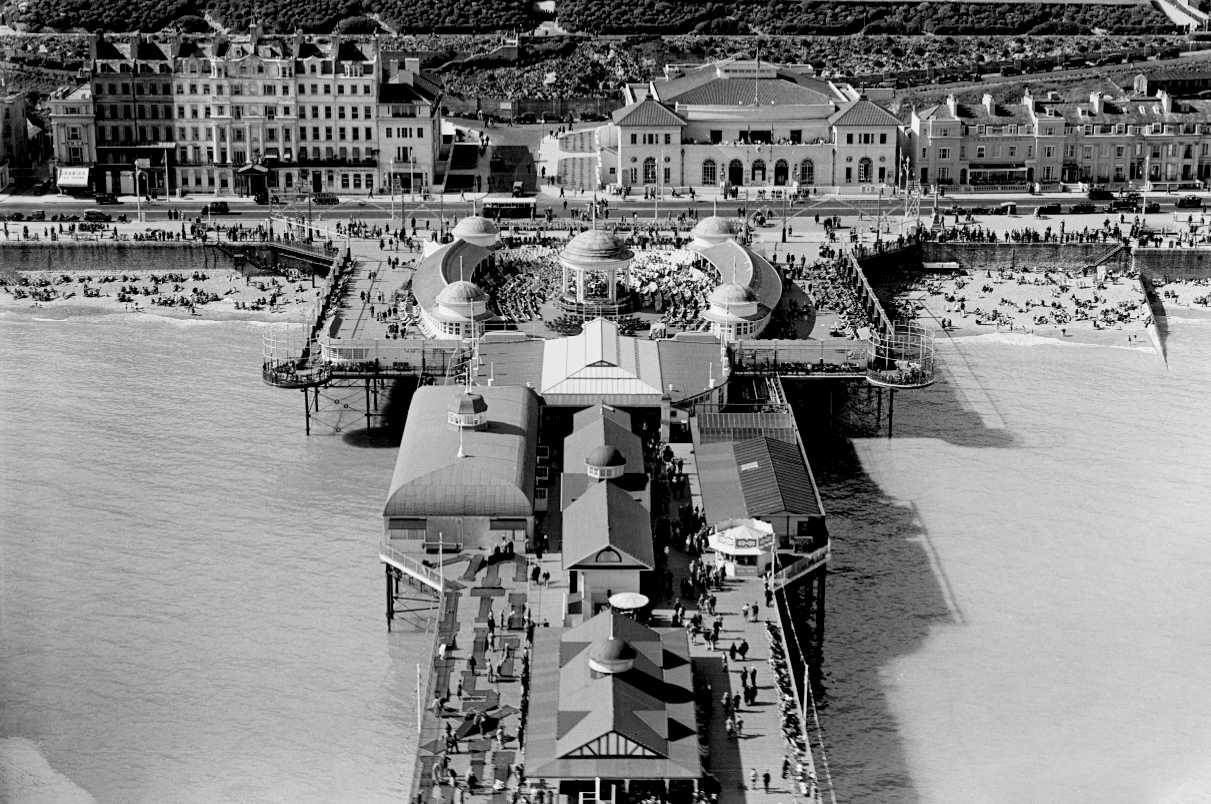
HASTINGS
PIER - Is seen in the picture above in fully operation
condition with crowds of people taking in the sea air and
wonderful coastal views. The restoration is nothing like this,
but at least the town can say that there is still a pier on
the original pile footprint.
THE
RESCUE PACKAGE - £14 MILLION RENOVATION PROJECT FOR HASTING
PIER TO GO AHEAD
A compulsory purchase order on Hastings Pier, derelict after years of neglect and a catastrophic fire, enacted yesterday has returned the pier to local ownership and enabled a £14m renovation project to go ahead. Work will now start this month with completion scheduled for Spring 2015. The project will boost the local jobs market during the reconstruction and will significantly lift the town’s visitor numbers. The CPO was put in place by Hastings Borough Council in support of the local ‘Save Our Pier’ campaign begun in 2008.
Now some £14m has been raised for the project, the lion’s share from the Heritage Lottery Fund (HLF) and significant amounts from the Coastal Communities Fund, the Community Assets Fund, Hastings Borough Council and the East Sussex Invest fund from East Sussex CC.
Initial works will include renovating the pier’s Grade II listed substructure, refurbishing the only pavilion still standing on the pier and the construction of a new visitor centre, which will also serve as an archive and display area for the pier’s rich local heritage. From its opening in 1872 through to its closure in 2008, Hastings Pier was the focus of tourism, events and entertainment for Hastings and much of the South of England.
"We want a new pier as well as to restore the old, using sustainable materials wherever we can. We’ll provide open space not just for promenading but for family and community celebrations; a real attraction for tourists and a valuable asset for locals and the town," said Simon Opie, CEO of the Hastings Pier Charity, which will oversee the build. “We want to offer a 21st. century take on the traditional English pier and for it to be used often by locals and visitors alike, a Peoples’ Pier.”
The heritage work includes a sound library of residents’ memories of the pier and will house and maintain a permanent record of the pier’s history. Once one of the busiest on the south coast, it was created as part of the Victorian seaside boom and evolved with the times, acting as the region’s centre for popular culture well into the 1970s and becoming an iconic venue for the post-war music culture, from the early days of rock and roll through to punk.
Cllr Peter Chowney, Hastings Borough Council lead member for regeneration, said: “Three years ago, Hastings Borough Council and the Pier Trust embarked on an ambitious project to restore the derelict and abandoned Hasting Pier. At that time, few believed we’d be successful. But, thanks to a close partnership between the trust and council to raise funding while pursuing a compulsory purchase order against Ravenclaw, it’s Panamanian-based owner, we persevered. A bid to the Heritage Lottery Fund for £11.4m was successful, and match funding was raised.
Now finally, with the transfer of ownership from Ravenclaw to the pier charity, the partnership has realised its goal; the pier is in local ownership and the money is in place to restore it.
So, today is a very important day in the history of Hastings Pier and a real cause for celebration. It’s a major step forward in returning Hastings Pier to its rightful place as a major attraction on our seafront.
We are very pleased to have played an essential part in the process of securing the future of the pier and will remain committed to working with the Hastings Pier Charity. A huge amount of work has gone into getting this result, and I would like to thank everyone involved.”
Carole Souter, Chief Executive of HLF, said: “This is great news for the future of Hastings Pier. We are full of admiration for Hastings Pier Charity and its successful campaign to ensure a much-loved landmark is saved and restored to its rightful place at the heart of the community. This ambitious project will also create jobs, opportunities for new skills to be mastered and provide the perfect environment for local people to get involved as things progress.”
Further background information and archive materials of the pier including photography are available at the Hastings Pier Charity website.
HASTINGS
PIER CONTACTS
WixHill PR: Dani West on 01483 203 992 / 07852 109 802, email:
dani@wixhill.co.uk or Tim Fordham-Moss on 01483 203 992 / 07710 491 788, email:
tim@wixhill.co.uk
Hastings Borough Council: Tracy Hobden on 01424 451 767
HLF Press Office: Katie Owen on 020 7591 6036 / 07973 613 820.
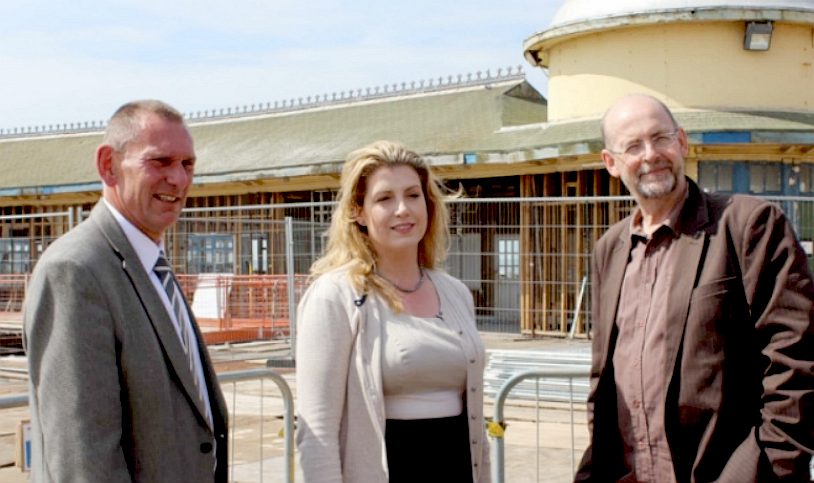
HISTORIC
ENGLAND NOTES:
Hastings Pier was built under an Act of Parliament and opened on 5 August 1872 on one of Britain's first ever bank holidays. The 'peerless pier' became one of the busiest on the south coast, flourishing during the Victorian seaside tourist boom. In later years it was popular as a venue for acts such as the Rolling Stones, Jimi Hendrix and Pink Floyd.
By the 1990s it had suffered storm damage and neglect from a succession of private owners, which resulted in its closure between 1999 and 2002 due to a change in ownership, and then again from 2006 after it was deemed unsafe. The fight to save the pier began in 2008 and, like many campaigns, an initial 'Friends of Hastings Pier' group developed into a more formal and incorporated development trust as the campaign gathered pace.
Hastings Pier and White Rock Trust (HPWRT) undertook considerable work initially to put the project on the political map and secure the support of local MPs. The group were able to convince Hastings Borough Council to make a CPO and sell the Pier immediately afterwards for £1 to the Hastings Pier Charity, a new charitable organisation set up to take ownership. To minimise risk to the Council, this 'back-to-back' agreement was dependent on the group demonstrating that they had sufficient expertise and financial resources to manage the refurbishment. Support to develop a robust business plan was provided by a feasibility grant of £75,000 from the Social Investment Business (SIB) Communitybuilders programme.
On the night of 5 October 2010, a suspected arson attack ravaged the pier and destroyed 95% of the superstructure. Hastings Borough Council immediately set about making the structure safe, and urgent remedial works were carried out with the contribution of a £100,000 grant from English Heritage and advice from the EH Engineering Team. A further EH grant of £20,000 helped to fund one structural survey to ascertain the extent of fire damage to the cast iron frame and prepare another on which a repair programme would be based. The HPWRT engineers ascertained that the cast iron and steel skeleton was still sound, meaning the pier could potentially be rescued. Later that year HPWRT applied for an £8.7m Heritage Lottery Fund (HLF) grant to try and secure the majority of the funding necessary to rebuild the pier. In April 2011 HPWRT were awarded HLF Round One funding, and given two years and a £340,000 development grant to submit a full proposal.
Since the fire the owners Ravenclaw (a company registered in Panama) had failed to respond to any of the council's letters, and in December 2011 Hastings Borough Council initiated the CPO process. The CPO was confirmed in 2012 by the Secretary of State without need for a public enquiry and the legal framework was in place to purchase the pier.
HPWRT submitted their final increased bid to HLF in August 2012 and a few months later Hastings got the news it had been waiting for: the full grant of £11.4m had been awarded. By May 2013 the additional £2.5m of funding from other sources was secured and HLF gave permission to start the works. With the general vesting conditions met, the CPO powers were enforced by the council and the freehold was transferred to Hastings Pier Charity on 14 August 2013.
A SUCCESSFUL MODEL
Refurbishment of the pier is now under way and is due to open in the summer of 2015. £8m of the project budget is being used to repair the ironwork substructure.
The previous layout of the pier was inflexible and over-developed, but the refurbished pier will include a new visitors' centre and a redeveloped pavilion, and will have more flexible outdoor space for visiting circuses, funfairs, festivals and open-air cinema events.
To ensure the pier is entirely self-funding, the Charity is developing partnerships with third-party organisations to create a dynamic and seasonal programme of events.
In the past the ownership of the pier has been a contentious issue, with a succession of private companies failing to generate and re-invest surpluses to maintain the town's iconic asset. The business model adopted by Hastings Pier Charity will reinvest all profits in the pier's maintenance.
Creation of a 'People's Pier', owned by local residents and businesses, is central to the vision and so the group were keen to offer a community share scheme.
Rather than dissolving the Charity and setting up a new legal entity, Hastings Pier Charity negotiated with the Charity Commission to make the transition from a Charity and Company Limited by Guarantee to a Community Benefit Society (Bencom), a form of Industrial and Provident Society with exempt Charity status (the first organisation to make such a transition following the Charities Act 2011).
The community share scheme closed in spring 2014 and has raised over £550,000 and created 3,000 shareholders. This has bridged the funding gap, generated working capital and most importantly has created a broad base of active members.
The CEO of Hastings Pier Charity, Simon Opie, believes a key to the project's success has been to stay flexible and re-engineer the plan to respond to changing circumstances.
Connecting into group wisdom has also been crucial, with the group receiving support from many organisations including the Community Shares Unit, Locality and Co-operatives UK. Seeking advice from groups that are on similar journeys, such as FC United in Manchester, has provided the group with the inspiration to keep going, knowing that they are not alone in breaking new ground.
FUNDING
The group has received local, regional and national support and substantial financial grant and loan funding totalling over £14m. This includes: English Heritage (£20,000); HLF (£11.4m); SIB Communitybuilders (£250,000); Coastal Communities Fund (£750,000); Architectural Heritage Fund (£350,000); Hastings Borough Council (£250,000); and Social Investment Business Community Assets Capital Grant (£500,000).
To ensure that the pier has a vibrant economic future the Charity is planning to invest the money raised through community shares in a range of income-generating assets on the pier. Ideas include the development of a micro-brewery, a children's play area, and a merchandising operation.
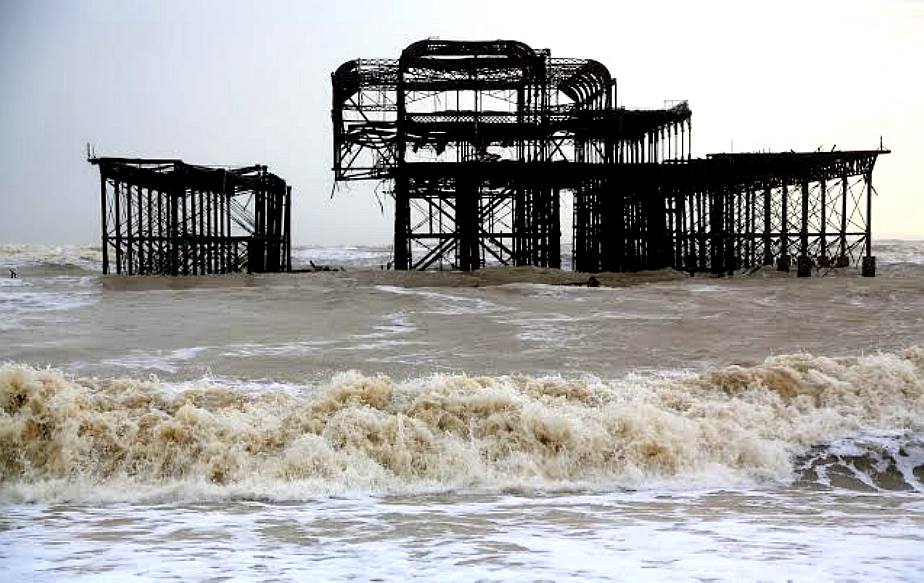
BRIGHTON
WEST PIER - The West Pier was a magnificent pier in Brighton, England.
As with Eastbourne's pier, it was designed by Eugenius Birch, opening in 1866 and closing in 1975. The pier was the first to be Grade I listed in Britain but
became increasingly derelict after closure. Listing is
therefore no security, but almost a death sentence in some
circumstances due to the increase in costs in planning terms.
We believe that planning fees should be waived concerning
major heritage assets, since councils are duty bound to help
conserve our heritage, but frequently become the fly
in the ointment. Planning officials have never been out in the
real commercial world, so do not appreciate that entertainment
halls have to be financially viable. Planning applications add
significantly to the cost of pier projects - to the point
where it may not be viable to throw good money after bad.
The pier was constructed during a boom
period in pleasure pier building in the 1860s, and was designed to attract
tourists to Brighton. It was the town's second pier, joining the Royal Suspension Chain Pier of 1823. It was extended in 1893, and a concert hall was added in 1916. The pier reached its peak attendance during this time, with 2 million visitors between 1918 and 1919. Its popularity began to decline after
World War
II, and concerts were replaced by a funfair and tearoom. A local company took ownership in 1965, but could not meet the increased maintenance cost, and ultimately filed for bankruptcy. They could not find a suitable buyer, so the pier closed in 1975 and subsequently fell into disrepair.
Eastbourne pier could suffer the same fate, simply because the
demand for seaside attractions is dead. Passing trade is all
but gone with all the out of town shopping parks, and
teenagers who might once have been attracted to the gaming
rooms can now get better thrills from their Playstations.
Parking is of course a problem. It now costs a fortune to park
nearby and that is if you can find a space.
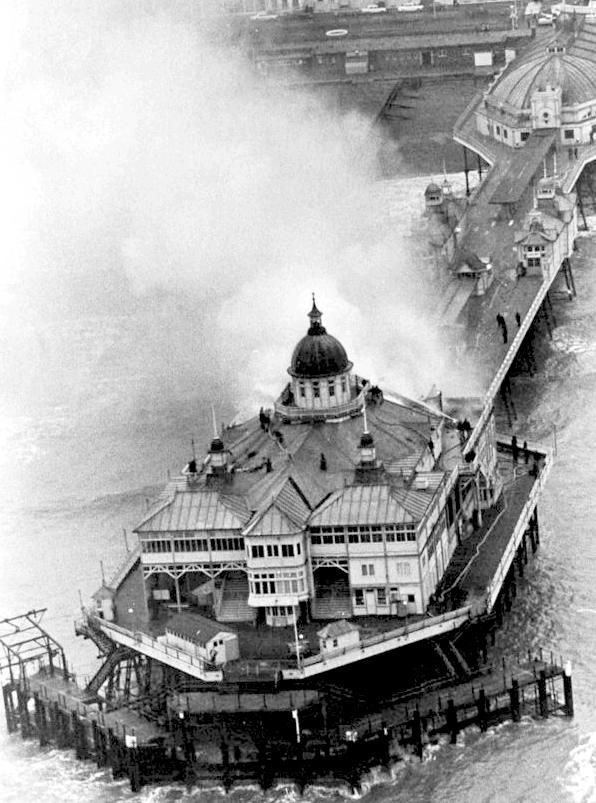
EASTBOURNE
PIER 1970 - Is seen in the picture above on fire at the
southern end in 1970. This is an example of a
heritage asset that could be put to better use to pull a
community together. With a track record of fires, any new
owner will have to be extra vigilant to do their utmost to
ward off potential arson attacks. Security will thus play a
major part in forward planning.
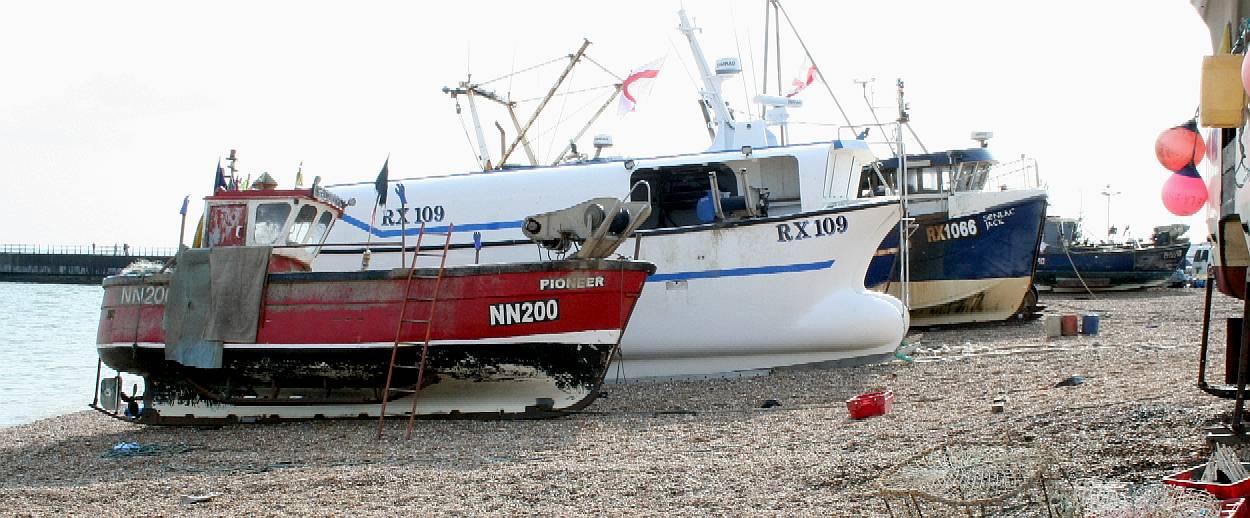
WORLD
RECORD FISHING FLEET - A
little known fact is that Hastings holds this world record for
being the biggest beach launched fleet of boats. The beach at
Hastings has been used for fishing for over a thousand years.
The shingle beach is called the Stade.
The name dates from before the 1066 battle of Hastings and
means " landing place ". The Stade was originally a
small area between today's boating lake and coach park, but
the building of the 1887 groyne at Rock-a-Nore and the 1896
harbour stopped shingle moving east along the coast. The
result was that the Stade then steadily grew out to sea,
providing new room for the fishing
fleet and many amenities.
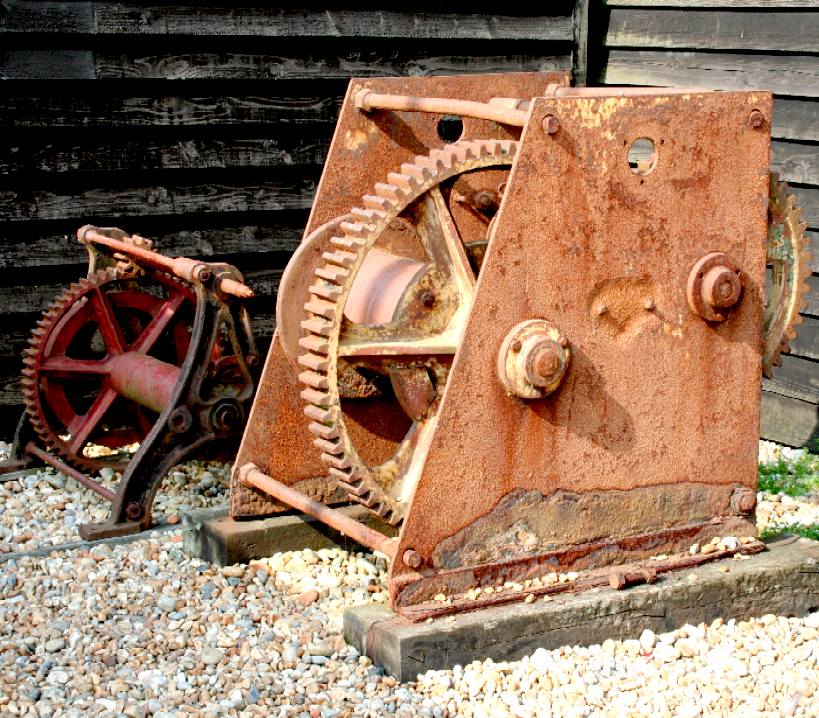
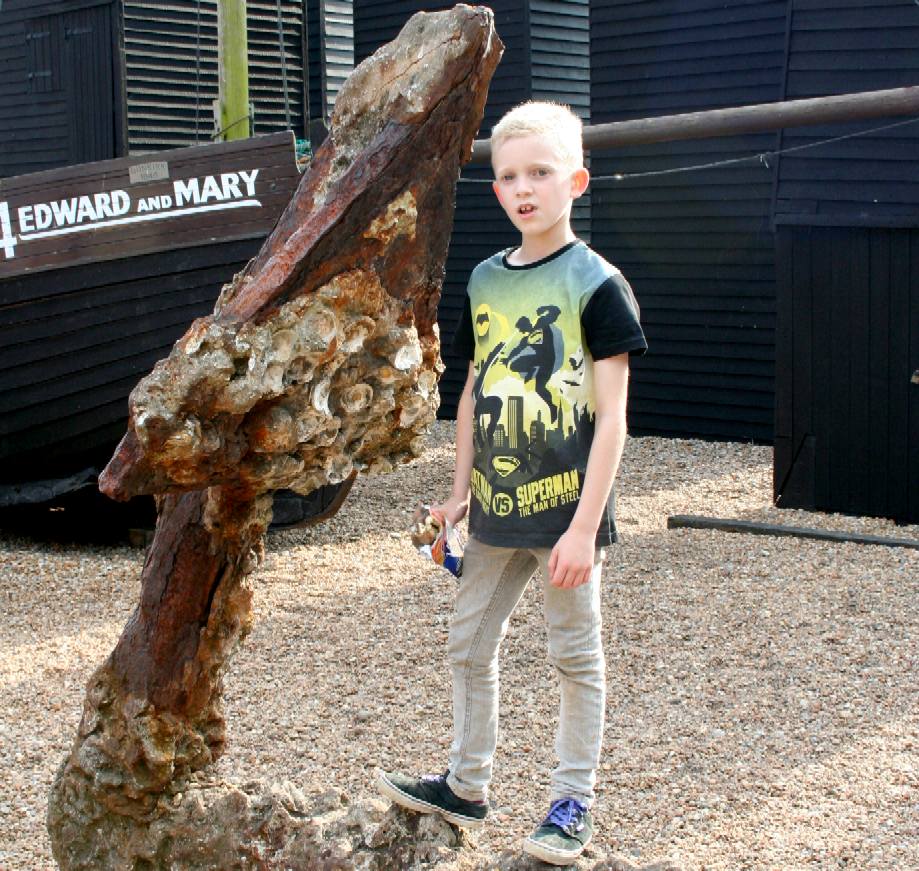
HASTINGS
NET
SHOPS - Other listed buildings is Hastings are the Old
Town’s Net Shops, consisting of approximately 50 black
wooden sheds standing in neat rows on a shingle beach are
unique. They were built to provide weather-proof stores for
fishing gear made of natural materials which rotted if wet for
a long time. Today’s materials are artificial and can be
left in the open. Most net shops stand on a piece of beach
that appeared suddenly after the first of the town’s groynes
were erected in 1834. The new beach area was small and close
to the sea, so each shop could only have about eight or nine
feet square to build on. But all boats had more nets than
could be stored in such limited space, so the sheds had to
grow upwards. Some have cellars. Many originally stood on
posts to let the sea go underneath. Fishermen keep spare gear
in the shops. One is a museum. The sheds were originally built
on posts to allow the sea to go underneath, however more
shingle has built up and the sea no longer reaches the huts.
The limited space meant the sheds had to grow upwards. Some
sheds have cellars.

LINKS
Dailymail-Eastbourne-2million-windfall-fire-destroyed-Grade-II-listed-pier-2014-Prime-Minister-knows-hit-town-hard
IOL
news
world England Hastings pier gutted by fire 2010
Heritage
Lottery Fund
Historic
England
Eastbourne
Borough Council
Big
Lottery Fund Coastal Communities Fund
https://www.hlf.org.uk/about-us/media-centre/press-releases/tide-turns-hastings-pier
Risk
Historic England register 46600 pier Hastings
http://risk.historicengland.org.uk/register.aspx?id=46600&rt=0&pn=1&st=a&ctype=any&crit=pier+hastings
https://www.hlf.org.uk/about-us/media-centre/press-releases/tide-turns-hastings-pier
https://www.biglotteryfund.org.uk/ccf
http://www.eastbourne.gov.uk/
http://www.hlf.org.uk/
http://www.historicengland.org.uk/
southeast@HistoricEngland.org.uk
|







